The first time I watched a seed grow into a thriving plant, it changed me. It made me feel connected to the earth in a new way. This moment started my journey into natural growing methods.
It’s not just about avoiding chemicals. It’s about working with nature to grow food. Whether you want to grow heirloom tomatoes or start a market garden, sustainable agriculture is the way to go. It’s good for you and the planet.
This guide will teach you about growing in harmony with nature. You’ll learn how to make soil that feeds your plants and manage pests without chemicals. You’ll also find out how to choose the right plants for your area.
Whether you’re new to gardening or already growing, you’ll find helpful tips here. By using these natural methods, you’re not just growing food. You’re helping to heal the earth and get amazing harvests.
Key Takeaways
- Working with natural systems creates healthier plants and more nutritious harvests
- Building living soil is the foundation of successful chemical-free growing
- Biodiversity in your garden naturally reduces pest problems
- Proper crop selection and rotation significantly improves yields
- Water conservation techniques save resources while improving plant health
- Natural growing methods benefit both local ecosystems and climate stability
Understanding the Principles of Organic Farming
Organic farming focuses on keeping the environment balanced and sustainable for the long run. It’s not just about avoiding harmful chemicals. It’s a way to work with nature, not against it.
The Philosophy Behind Sustainable Agriculture
Sustainable agriculture sees a farm as a living system. It includes everything from soil microbes to pollinators. This approach believes a healthy farm is more than its parts.
At the heart of organic farming is soil health. Healthy soil grows healthy plants. These plants then support the health of people and animals. This cycle is the core of organic farming.
Organic farmers aim for long-term solutions, not quick fixes. They build systems that can handle environmental challenges naturally over time.
Key Differences Between Conventional and Organic Methods
Organic farming is different from conventional methods in many ways. It’s not just about what you don’t use. It’s about how you farm.
| Aspect | Conventional Farming | Organic Farming |
|---|---|---|
| Pest Management | Synthetic pesticides | Biological controls, beneficial insects |
| Fertilization | Chemical fertilizers | Compost, manure, cover crops |
| Weed Control | Herbicides | Mulching, crop rotation, manual removal |
| Seed Selection | Often GMO varieties | Non-GMO, often heirloom varieties |
To get USDA organic certification, you need to keep detailed records. This shows you follow organic rules. These rules ban synthetic chemicals and GMOs.
Environmental and Health Benefits of Going Organic
Organic farming is good for the environment. It cuts down on water pollution and protects bees and butterflies.
Organic farms have 30% more biodiversity than non-organic ones. This diversity helps fight pests and diseases naturally. It makes ecosystems healthier.
Organic food has fewer pesticides than non-organic. Some studies say it might have more nutrients and antioxidants. But more research is needed.
Learning about organic farming helps you start your own sustainable farm. You can create a system that lasts for generations.
Getting Started: Essential Organic Farming Tips
Starting an organic farm needs good preparation and knowing your resources. Understand your land’s strengths and plan carefully. This will help you succeed in the long run.
Assessing Your Land and Resources
Start by really getting to know your land. Walk it at different times to see how the sun hits it. Note where it’s sunny, shady, or somewhere in between.
Look for natural water sources and how water moves across your land. Also, watch for signs of life like insects, birds, and plants. These can help your farm grow.
Key factors to evaluate include:
- Soil quality and composition
- Water availability and access
- Sunlight exposure throughout seasons
- Natural windbreaks and shelter
- Existing plant and animal life
Creating a Sustainable Farm Plan
With a good understanding of your land, you can make a solid farm plan. Start with goals that fit your resources and experience.
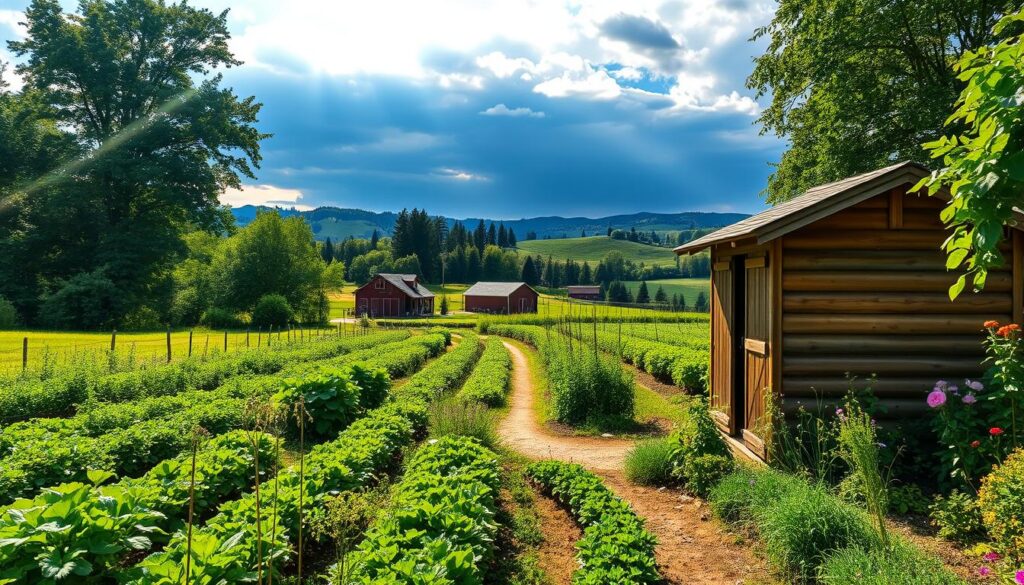
Choose crops that match your climate and soil. Start small with a few crops in your first season.
Plan out where you’ll grow things, paths, and what you need. Make a schedule for planting, upkeep, and harvest. This should fit your local growing season and your schedule.
Basic Equipment and Tools for Organic Farming
Having the right tools makes farming easier and more fun. Choose tools that fit your farm’s size for long-term use.
Hand Tools vs. Machinery Considerations
How big your farm is will decide what tools you need. Small farms often do well with hand tools. But bigger farms might need machinery.
| Consideration | Hand Tools | Machinery | Best For |
|---|---|---|---|
| Initial Cost | Lower investment | Higher investment | Budget-conscious beginners |
| Maintenance | Simple, inexpensive | Complex, potentially costly | Those with limited mechanical skills |
| Environmental Impact | Minimal carbon footprint | Fuel consumption, emissions | Highly eco-conscious farmers |
| Labor Efficiency | More physical effort | Less physical effort | Larger acreage operations |
| Soil Impact | Minimal soil compaction | Potential compaction issues | Delicate soil ecosystems |
Sustainable Material Choices
When building your farm, pick materials that are organic-friendly. Use untreated wood, recycled metal, or repurposed stuff when you can.
Think about using bamboo for trellises, natural stone for paths, and reclaimed wood for beds. These choices are better for the environment and keep your farm organic.
Building Healthy Soil: The Foundation of Organic Success
Healthy soil is key to successful organic farming. It’s different from conventional farming, which uses synthetic inputs. Organic farming focuses on improving the soil ecosystem.
Creating and keeping healthy soil is more than a task. It’s the core of sustainable farming.
Understanding Your Soil Type and Composition
Before starting any soil management, know your soil. Soil types vary, each with its own traits.
The main types are sandy soil, clay soil, and loamy soil. Sandy soil drains fast but holds little nutrients. Clay soil holds nutrients well but drains slowly. Loamy soil is the best, balancing both.
| Soil Type | Water Retention | Nutrient Holding | Workability | Best Crops |
|---|---|---|---|---|
| Sandy | Poor | Low | Easy | Root vegetables, herbs |
| Clay | Excellent | High | Difficult | Late-season crops, fruit trees |
| Loam | Good | Good | Moderate | Most vegetables |
| Silt | Moderate | Moderate | Moderate | Moisture-loving crops |
Soil Testing Methods and Interpretation
Soil testing is essential for improving your soil. DIY kits give basic info on pH and nutrients. They’re good for small farms.
For detailed analysis, use professional labs. They test for nutrients, organic matter, and contaminants. Many extension offices offer affordable tests and help with understanding the results.
The nation that destroys its soil destroys itself.
When looking at test results, aim for balanced nutrients. Most crops prefer a pH between 6.0-7.0. Some need more acidic or alkaline conditions.
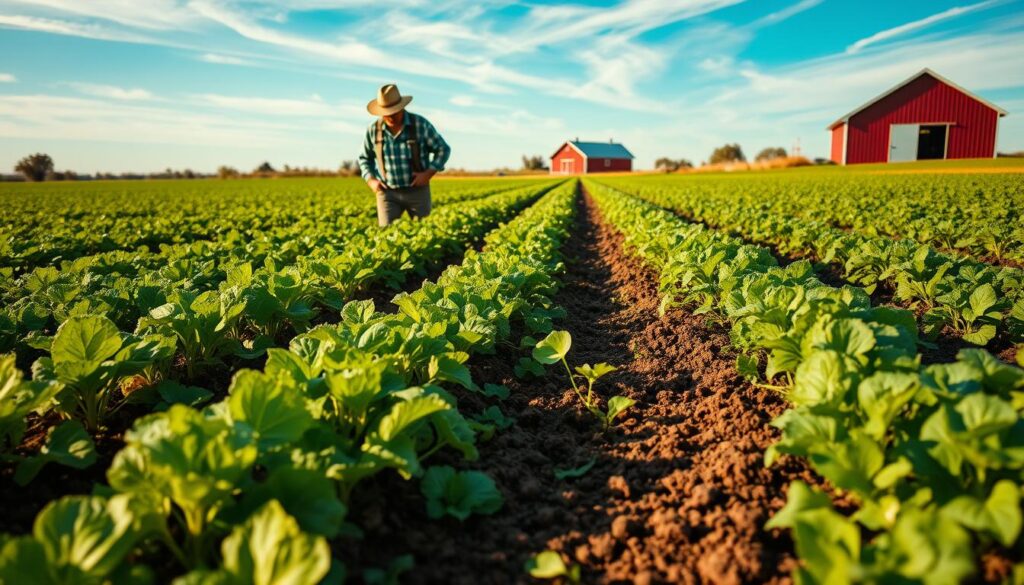
Soil Management Strategies for Long-term Fertility
Good soil management means building fertility and keeping soil structure. Organic farming focuses on long-term results, unlike synthetic fertilizers.
Preventing Erosion and Compaction
Soil erosion is a big problem. Use contour plowing on slopes to slow water. Keep the soil covered with crops or mulch to protect it from wind and rain.
Compaction hurts root growth and soil life. Avoid heavy equipment when soil is wet. Use tools like broadfork to loosen soil without damaging it.
Encouraging Beneficial Soil Organisms
Healthy soil is full of microorganisms. These tiny creatures are key to soil fertility.
To help them, add organic matter often. Reduce tillage to protect fungal networks. Use compost tea or microbial inoculants to boost beneficial organisms.
Avoid broad-spectrum pesticides. They harm good organisms too. Instead, use targeted methods to solve specific problems.
Organic Fertilizers and Natural Amendments
Organic fertilizers and natural amendments are key to sustainable farming. They improve soil health over time, unlike synthetic fertilizers. These natural solutions work with the soil, creating a strong base for sustainable farming.
Composting Techniques for Farm-Scale Operations
Farm-scale composting is different from backyard composting. It’s bigger and needs more management. When done right, it turns waste into valuable soil amendments, saving money and the environment.
Hot Composting Methods
Hot composting speeds up decomposition by creating the right conditions for microorganisms. Build piles that are at least 3 feet by 3 feet to keep them hot. Aim for a carbon-to-nitrogen ratio of 30:1 by mixing “browns” and “greens”.
Check the pile’s temperature often, aiming for 131-155°F. Turn it when it gets too hot to keep microbes alive. Keep it moist and aerated for best results.
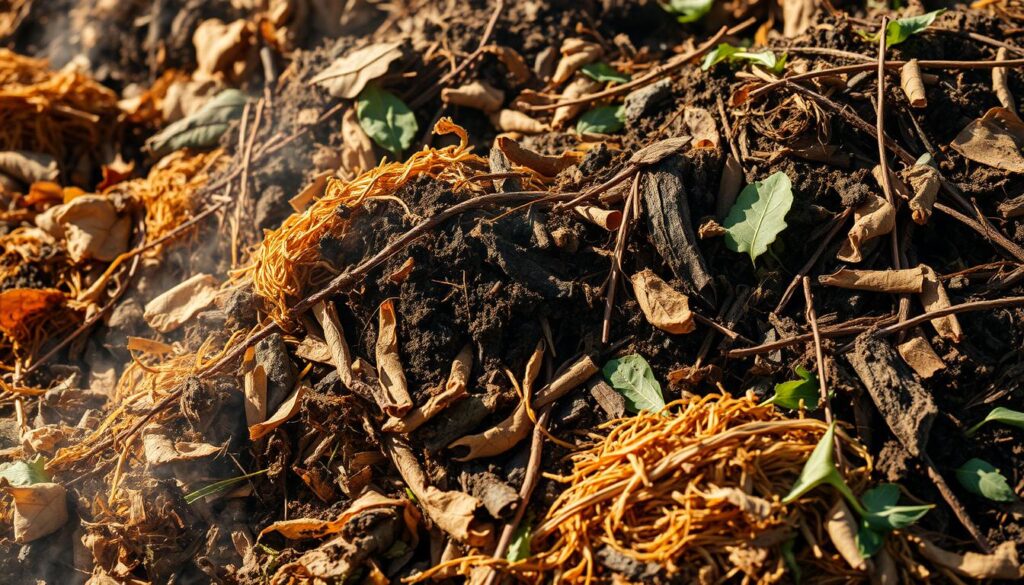
Vermicomposting uses worms to make nutrient-rich amendments. Red wigglers are the best for this. They turn waste into worm castings full of nutrients and microbes.
For farms, use flow-through systems to harvest continuously. These systems can handle a lot of waste, making top-quality castings for soil or potting mix.
Animal Manures: Selection and Application
Not all manures are the same. Chicken manure has more nitrogen than horse or cow manure. Always age or compost raw manure to avoid nitrogen burn and pathogens.
For food crops, use composted manure 120 days before harvest for soil contact crops. For non-soil contact crops, use it 90 days before. This ensures safety and maximizes nutrients.
Mineral Amendments and Natural Supplements
Use mineral amendments to meet your soil’s needs. Rock phosphate and greensand provide phosphorus and potassium. Kelp meal boosts growth and supports plant immunity.
Microbial inoculants improve nutrient cycling and availability. They help create a soil food web that supports healthy plants without synthetic inputs.
By using these organic fertilizers and amendments, you’ll create soil that grows healthy plants naturally. This improves your farm’s resilience and sustainability every year.
Cover Crops and Green Manures
Using cover crops and green manures is a key soil management strategy for organic farmers. These plants keep the soil healthy when your main crops are not growing. They turn downtime into a chance to improve the soil.
By using these methods, you can increase organic matter, stop erosion, and fight weeds without chemicals.
Selecting the Right Cover Crops for Your Climate
Each cover crop has its own benefits for your soil. Legumes like clover and vetch add nitrogen naturally. Deep-rooted plants like daikon radish help water and air move through the soil.
Choose cover crops based on your climate and growing season. Winter rye is good for cold areas, while cowpeas and buckwheat are better in warmer places. Pick what you need most—nitrogen, organic matter, or erosion control.

Timing and Methods for Planting Cover Crops
Planting at the right time is key. Plant cool-season crops like oats and rye in late summer or early fall. Warm-season crops like sorghum-sudangrass do well in spring when it’s warmer.
For small areas, broadcasting seeds works well. For bigger plots, drilling is better. Make sure the soil is moist for germination. Lightly mixing seeds with a harrow helps them grow better.
Incorporating Green Manures into Your Soil
Green manures are cover crops turned into the soil. They need careful management for the best results. Cut most cover crops at the flowering stage to get the most nutrients.
You can incorporate them in a few ways. Mow and let the residue decompose, use a roller-crimper, or till them into the soil. Wait 2-3 weeks before planting again to avoid harming new seedlings.
Keep “living mulches” like white clover between rows. These cover crops protect the soil and help beneficial insects control pests naturally.
Seed Selection and Planting Techniques
Your success in organic farming starts with the seeds you choose and how you plant them. Using organic, untreated seeds is key to a chemical-free garden or farm. These early choices lead to healthier plants and more food.
Choosing Heirloom and Open-Pollinated Varieties
Heirloom seeds are great for organic farmers who want to grow food that tastes good and is sustainable. These seeds have been passed down for generations. They help crops adapt to local conditions over time.Why choose heirloom and open-pollinated seeds:– They let you save seeds year after year, saving money
– They often taste better than commercial varieties
– They help keep farming diverse and preserve culture
– They get better with each growing season
Unlike hybrid or GMO seeds, heirlooms fit well with organic farming. Many farmers find that Cherokee Purple tomatoes, Blue Lake beans, and Five Color Silverbeet Swiss chard grow well in organic settings.
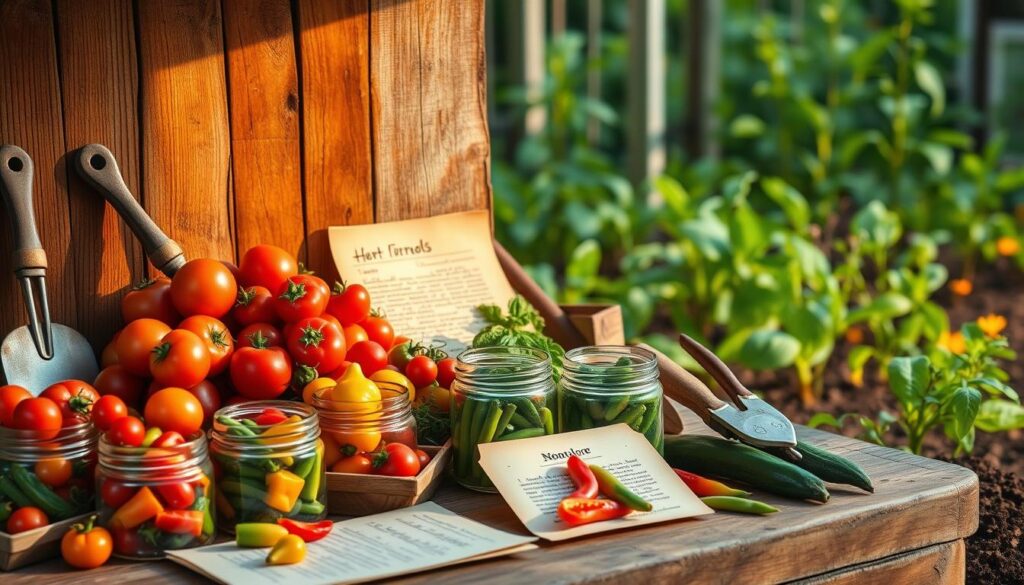
Seed Saving and Storage Methods
Learning to save seeds is a key part of organic farming. It connects you to the whole growing process. Different plants need different ways to save seeds.
For dry seeds like beans and peas, wait until the pods dry completely. For wet seeds like tomatoes and cucumbers, fermentation removes a gel that stops germination.
Storing seeds right is important to keep them good for planting. Put cleaned, dried seeds in paper envelopes or glass jars in a cool, dark place. Label each with the type and when you saved it. Most seeds stay good for 2-5 years, but it depends on the type.
Optimal Planting Strategies for Different Crops
Organic farming needs a plan for each crop. Think about soil temperature, how much water it needs, and when to plant.
Direct Seeding vs. Transplanting
Choosing between direct seeding and transplanting depends on several things:
| Factor | Direct Seeding | Transplanting |
|---|---|---|
| Crop Type | Root crops, legumes, corn | Tomatoes, peppers, brassicas |
| Growing Season | Longer growing seasons | Shorter growing seasons |
| Resource Efficiency | Less labor-intensive | More controlled environment |
| Germination Rate | May be lower in field | Higher in controlled setting |
| Transplant Shock | None | Possible setback to growth |
Succession Planting for Continuous Harvests
Succession planting means planting crops at different times for a steady harvest. It makes your garden more productive and keeps you with fresh food.
Plant fast-growing crops like radishes or lettuce every 2-3 weeks. This way, as one crop is done, another starts. It’s great for greens, root veggies, and bush beans.
Another good trick is to plant fast-growing crops between slower ones. For example, plant radishes between carrots. Harvest the radishes before the carrots need the space.
Crop Rotation and Companion Planting Methods
Organic farming uses crop rotation and companion planting as key tools. These methods help grow strong, pest-free crops. They also boost yields and reduce the need for chemicals.
Designing Effective Rotation Cycles
Crop rotation means changing what you grow in a spot over time. Effective cycles prevent pests by breaking their life cycles. A good cycle might go from leaf crops to fruit, then to root, and end with legumes.
Never grow the same family of crops in one spot for two years in a row. This stops pests and diseases from getting too comfortable.
Companion Planting for Pest Management and Yield Improvement
Companion planting uses plants’ natural friendships. Some plants keep pests away, while others attract good bugs.
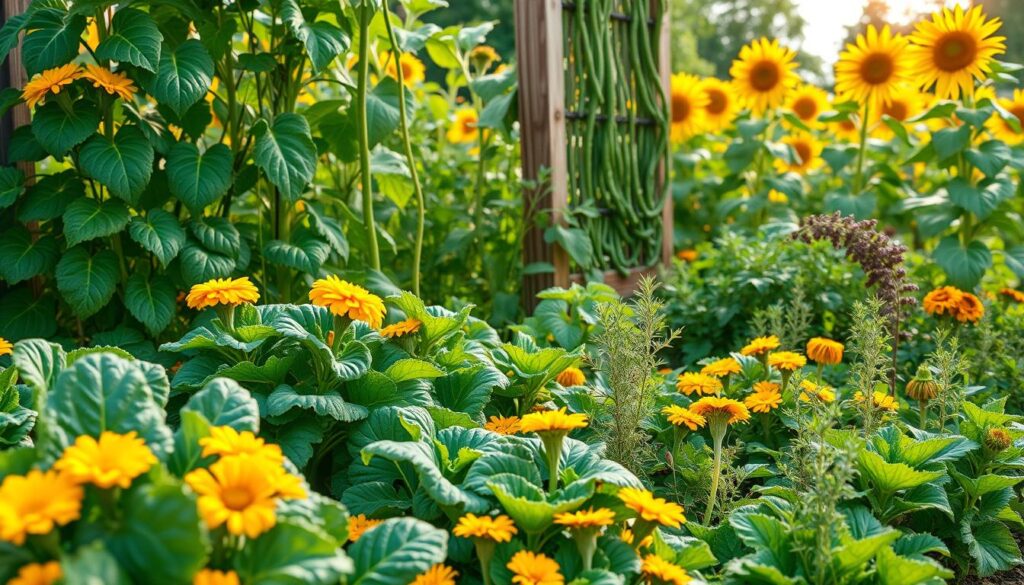
For example, tomatoes and basil together taste better and keep flies away. Carrots and onions repel each other’s pests. The “Three Sisters” of corn, beans, and squash work together too. Corn supports beans, beans fix nitrogen, and squash keeps weeds down.
Intercropping Strategies for Maximum Land Use
Intercropping grows more than one crop in the same space. It uses space well and helps plants work together.
There are a few ways to intercrop:
- Row intercropping: Plant different crops in rows that alternate.
- Strip intercropping: Grow crops in wider strips.
- Relay intercropping: Plant a second crop before you harvest the first.
- Mixed intercropping: Plant two or more crops without rows.
Plant Families and Their Rotation Requirements
Knowing plant families helps with crop rotation. Each family needs different nutrients and fights off pests and diseases in its own way.
| Plant Family | Common Crops | Rotation Wait Period | Following Crop Recommendation |
|---|---|---|---|
| Solanaceae (Nightshades) | Tomatoes, Peppers, Potatoes, Eggplant | 3-4 years | Legumes or Brassicas |
| Brassicaceae (Cabbage family) | Broccoli, Cabbage, Kale, Radish | 3 years | Alliums or Cucurbits |
| Fabaceae (Legumes) | Beans, Peas, Lentils | 2 years | Heavy feeders like Nightshades |
| Cucurbitaceae (Squash family) | Cucumbers, Squash, Melons | 2-3 years | Alliums or Legumes |
Using crop rotation methods and companion planting makes farming better. Your crops will grow stronger, fight pests better, and need less chemicals.
Natural Pest Control Without Chemicals
Protecting your organic crops from pests doesn’t need harsh chemicals. Nature has many effective alternatives. Using natural pest control methods keeps your harvest safe and preserves soil health. Success comes from prevention, early detection, and using nature’s defense systems.
Identifying Common Garden Pests and Diseases
Effective pest management starts with knowing what pests look like. Regularly check your plants for unusual spots, holes, or color changes. Look under leaves where insects hide and lay eggs.
Keep a garden journal to track pest patterns. Many pests show up in certain seasons or weather. Knowing the difference between pests and beneficial insects helps avoid unnecessary actions.
Beneficial Insects and How to Attract Them
Nature has its own pest control team in beneficial insects. Ladybugs, lacewings, and parasitic wasps eat common pests. To attract them, plant herbs like dill, fennel, and yarrow for nectar and pollen.
Make insect habitats with small stone or wood piles in your garden. Avoid sprays that harm beneficial insects too.
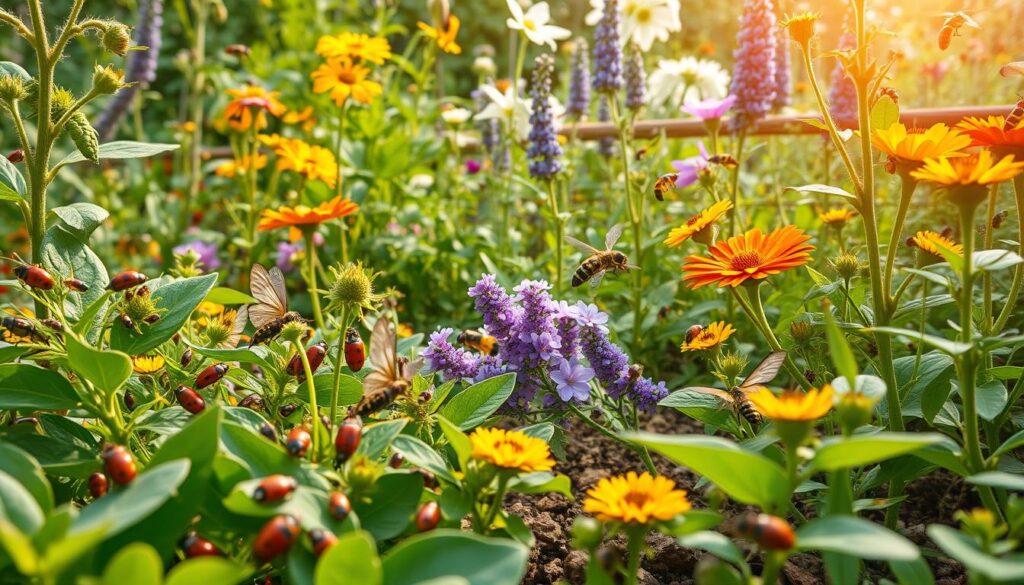
Homemade Organic Pest Deterrents
Herbal Sprays and Infusions
Use plants to make pest deterrents. Garlic spray fights aphids and small insects. Blend 4-5 cloves with 2 cups water, strain, and add a teaspoon of liquid soap.
Hot pepper spray keeps chewing insects away. Steep 2 tablespoons of hot pepper flakes in a quart of water, then strain and spray. Always test these solutions on a small area first to ensure they don’t damage your plants.
Soap and Oil-Based Solutions
Insecticidal soaps harm soft-bodied insects like aphids and mites. Mix 1 tablespoon of mild liquid soap with 1 quart of water. For stronger protection, add 2 tablespoons of vegetable oil to create a soap-oil spray that coats and suffocates pests.
Neem oil repels and disrupts insect growth. Dilute as directed and apply during cooler parts of the day to prevent leaf burn.
Physical Barriers and Trap Crops
Sometimes, the simplest solutions are the best. Floating row covers protect crops from flying insects while allowing sunlight and water. Copper tape keeps slugs and snails away.
Use trap crops like nasturtiums or radishes to draw pests away from your main harvest. These plants attract pests, protecting your valuable crops. Remove and dispose of trap crops once infested.
Water Conservation and Irrigation Techniques
Learning how to save water and use it wisely is key for organic farmers. With more droughts and water limits, it’s not just good for the planet. It’s also a must for your farm to stay afloat.
Efficient Watering Systems for Organic Farms
The right irrigation system can cut down water waste and make sure your crops get the right amount of moisture. Drip irrigation is the top choice, getting water to roots with 90% efficiency. Sprinklers only manage 50-70%.
Micro-sprinklers are great for trees and big plants, giving a gentle spray like rain. If your land is sloped, gravity-fed systems can save on electricity and costs.
| Irrigation Method | Water Efficiency | Initial Cost | Best For | Maintenance Level |
|---|---|---|---|---|
| Drip Irrigation | 90-95% | Moderate | Row crops, vegetables | Medium |
| Micro-sprinklers | 80-85% | Moderate | Orchards, berries | Low |
| Soaker Hoses | 70-80% | Low | Small gardens, beds | Very low |
| Gravity-fed | 60-70% | Variable | Sloped terrain | Low |
Rainwater Harvesting Methods
Catching rainwater cuts down on the need for tap or well water. It also gives plants clean water. Small farms can use barrel systems, while bigger ones might need ponds or cisterns.
When setting up your rainwater system, think about filters and how much water you’ll store. A rule of thumb: one inch of rain on 1,000 square feet gives about 600 gallons.
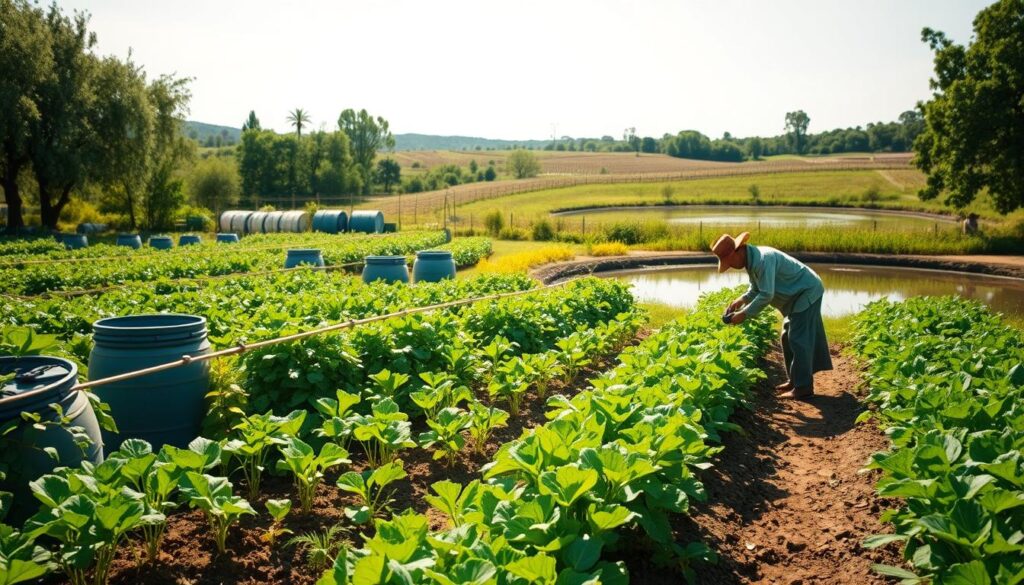
Drought-Resistant Farming Practices
There’s more to saving water than just irrigation. How you farm can also make a big difference. Contour planting and keyline design help manage water better.
Mulching for Moisture Retention
Organic mulch around your plants can cut down evaporation by up to 70%. Straw mulch is good for veggies, while wood chips last longer for trees and perennials. Keep it 2-4 inches thick, but not touching plant stems to avoid rot.
Selecting Drought-Tolerant Varieties
Picking plants that don’t need much water is smart. Heirloom varieties from dry places often need less water. Look for sunflowers, sorghum, and certain beans that can find water deeper in the soil.
Conclusion: Your Path to Organic Farming Success
Starting organic farming might seem tough at first, but the benefits are huge. By using the tips from this guide, you’ll grow a healthy farm. This farm will give you fresh food and help the planet.
Organic farming is all about working together. Healthy soil grows strong plants. These plants attract good bugs, keeping pests away. It’s a cycle of growth and balance.
Start small with a plot you can handle. Test different ways to farm sustainably. Watch what works in your area and take notes. This will help you learn and grow.
Your farm does more than just grow food. It helps the environment, improves water, and fights climate change. Every bit of organic farming helps.
Join local farmers or online groups. They offer support and advice. You’ll learn how to handle the ups and downs of farming.
More people want organic food, which is good for farmers. Getting certified takes time, but the extra money and loyal customers are worth it.
Start making changes today. Try composting, planting cover crops, or making a crop rotation plan. Every step brings you closer to a sustainable farm that benefits everyone.
FAQ
What is the fundamental difference between organic and conventional farming?
Organic farming uses natural processes. It avoids synthetic fertilizers and pesticides. Instead, it builds resilient ecosystems with natural inputs and biological pest control.
The goal is to create sustainable systems. These systems maintain soil health, support biodiversity, and produce nutritious food without synthetic chemicals.
How long does it take to transition to certified organic farming?
It takes three years to transition to certified organic farming. During this time, you must follow organic practices. Your land will go through a cleansing process to eliminate chemical residues.
You’ll need to keep detailed records of your practices and inputs. Work with a certification agency and pass regular inspections. This challenging period helps you develop organic management skills and establish biological systems for successful production.
What equipment do I need to start a small organic farm?
Start with quality hand tools: a durable spade, garden fork, hoe, rake, pruners, and a wheelbarrow. As you expand, consider a broadfork for deep soil aeration and a quality irrigation system.
Row covers for pest protection and a small walk-behind tiller (though many organic farmers minimize tillage) might be needed. For larger operations, a small tractor with appropriate attachments could be necessary. Prioritize durable, ergonomic tools suited to your specific crops and soil conditions.
How do I improve poor soil quality organically?
Start by conducting a soil test to understand your soil. Then, add organic matter through compost and aged manure. Grow cover crops to add nutrients and organic material.
Apply mineral amendments based on your soil test results. Use mulches to protect soil and add organic matter as they break down. Minimize soil disturbance through reduced tillage. Introduce beneficial microorganisms through compost tea or commercial inoculants. Consistently applying these strategies will gradually transform poor soil.
What are the best composting techniques for a farm-scale operation?
For farm-scale composting, use hot composting methods that reach temperatures of 131-160°F. Build windrows or large piles (at least 3’x3’x3′) with the proper carbon-to-nitrogen ratio (about 30:1).
Layer carbon-rich materials (straw, leaves, wood chips) with nitrogen-rich materials (manure, green plant matter, food scraps). Monitor moisture and turn the pile when temperatures begin to drop. For large operations, consider investing in compost turning equipment or a windrow turner to manage the process efficiently.
Which cover crops work best for fixing nitrogen in the soil?
Leguminous cover crops are the most effective for fixing nitrogen in soil. Excellent options include: clover varieties (red, white, crimson) for various climate zones; field peas and vetch for cool-season planting; cowpeas and sunn hemp for warm seasons; and alfalfa for longer-term soil building.
These plants form symbiotic relationships with rhizobia bacteria in their root nodules, converting atmospheric nitrogen into plant-available forms. For maximum nitrogen fixation, ensure proper inoculation with the appropriate rhizobia strain when planting legumes in an area for the first time.
How do I save seeds from my organic crops?
To save seeds successfully, start by selecting open-pollinated or heirloom varieties (not hybrids). Allow the healthiest plants to fully mature their seeds beyond the eating stage.
For wet-seeded crops like tomatoes and cucumbers, ferment the seeds in water for a few days to remove germination inhibitors before drying. For dry-seeded crops like beans and grains, allow pods to dry on the plant before harvesting. Clean all seeds thoroughly, dry them completely, and store in airtight containers in a cool, dark place. Label everything with variety name and date. Be aware of cross-pollination issues with certain crop families that can affect seed purity.
What are some effective companion planting combinations for pest control?
Several companion planting combinations effectively deter pests: plant aromatic herbs like basil near tomatoes to repel tomato hornworms; interplant marigolds throughout your garden to deter nematodes and many insects; grow nasturtiums as trap crops for aphids.
Plant onions, garlic, or chives near carrots to confuse carrot flies; combine beans with rosemary or savory to deter bean beetles; surround brassicas (cabbage, broccoli) with aromatic herbs like thyme and sage to repel cabbage moths; and plant calendula to attract beneficial insects that prey on common pests. These companion planting methods work through various mechanisms including masking scents, producing repellent compounds, or attracting beneficial predators.
How can I make effective homemade organic pest sprays?
You can make several effective organic pest sprays at home. For a basic garlic-pepper spray, blend 4 cloves of garlic and 2 hot peppers with 2 cups of water, strain, add a few drops of biodegradable soap, and dilute with a gallon of water before spraying.
Neem oil spray (2 tablespoons neem oil, 1 teaspoon mild liquid soap, 1 gallon water) works against many insects by disrupting their hormonal systems. For fungal issues, try a baking soda spray (1 tablespoon baking soda, 1 teaspoon mild liquid soap, 1 gallon water). Always test sprays on a small area first, apply in the early morning or evening to avoid leaf burn, and reapply after rain.
What are the most water-efficient irrigation systems for organic farms?
Drip irrigation is the most water-efficient system for organic farms, delivering water directly to plant roots with minimal evaporation or runoff. Soaker hoses offer similar benefits with less precision but lower cost. For larger areas, low-pressure micro-sprinklers provide efficient coverage while reducing water use compared to conventional sprinklers.
Combine these systems with timers, moisture sensors, and proper scheduling based on plant needs and weather conditions. Implement water-conserving practices like mulching, windbreaks, contour planting, and building soil organic matter to increase water retention capacity.
How do I manage weeds without herbicides in organic farming?
Manage weeds organically through multiple strategies: prevent weed establishment with mulches (straw, wood chips, landscape fabric); use cover crops to outcompete weeds; implement timely cultivation with appropriate tools like stirrup hoes, wheel hoes, or tractor-mounted cultivators.
Practice the stale seedbed technique (preparing beds early to germinate and remove weeds before planting); use flame weeding for bed preparation or between rows; employ strategic crop rotation to disrupt weed cycles; and hand weed when necessary, focusing on removing weeds before they set seed. The key is consistent, timely intervention when weeds are small, combined with preventive measures to reduce the overall weed pressure.
What’s the best way to build soil organic matter quickly?
To build soil organic matter quickly, implement multiple strategies simultaneously: apply finished compost at rates of 1-2 inches per year; grow and incorporate cover crops, such as rye, sorghum-sudangrass, or buckwheat; use organic mulches that break down over time; apply appropriate rates of well-aged animal manures; minimize soil disturbance through reduced tillage practices; and implement managed grazing if appropriate for your operation.
While there’s no instant solution, this multi-faceted approach can significantly increase organic matter within 2-3 years. It improves soil structure, water retention, and nutrient cycling.